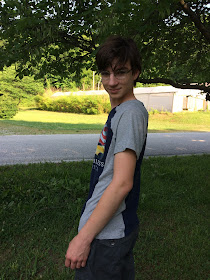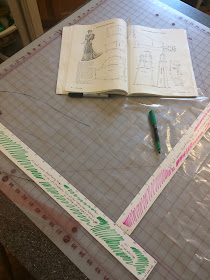Well, it would become a reality, after I perfected the pattern. It turns out measuring your own back length (nape of neck to small of back), all by yourself, does not produce very accurate results. Somehow, by doing this, I added over an inch to my back length. Then I used that too long measurement to make my back measure apportioning ruler. The result? My first mockup fit perfectly around, it was just much too long. It wrinkled horribly at the waistline and the skirt dragged on the floor.
The skirt length? That could be easily chopped and fixed. But the bodice length? That required some pattern alteration.
I pulled out my plastic pattern and folded an inch out of the bodice length, right above the waistline, on every single pattern piece. Then I made another mock-up.
Mock-up #2 fit better than mock-up #1, but it wasn't perfect. The center back length, from neck to waist, was just about right, but the side panels were still too long. So, I pulled out my plastic pattern again and folded another inch of length out of the side panels only.
That done, I made another mock-up, and it appeared that the third time was the charm!
No wrinkles this time!! The main tea gown pattern was good, and I could move on to perfecting the sleeves. Those took another 3 mock-ups.
Eventually, I had a flounced sleeve puff thing that resembled the sleeves of my inspiration tea gown.
The very last thing I did to my pattern was make some minor alterations to the pleat arrangement on my under bodice pieces.
To give my tea gown the structure it needed, I flatlined the entire thing with black cotton broadcloth. The flat lining was the first thing I cut out, and it ate up an entire 8 yard bolt of black cotton!
After ironing and lint-rolling (black cotton is a magnet for wrinkles, lint, and pet hair!) each individual piece, I marked the "right side" of each one with a safety pin. (Both sides of the black cotton look and feel exactly the same.) I would be using my flat lining as the pattern to cut out my silk, so these safety pins would allow me to be extra sure I wouldn't cut out any pieces backwards. I didn't have enough of my green and black silk jacquard to make any cutting mistakes!
When I bought the fabric in Malaysia, I didn't buy enough for a tea gown the first time I was in the fabric shop. I only bought 2 meters, and I had no specific plan for the fabric. Upon returning to my Airbnb with my purchase, I realized it was the perfect fabric for the tea gown I'd been dreaming of! I was going to have to go back to the fabric shop to get more! Well, it was a week before I managed to do that. When I returned to the shop, all that was left of my silk was a remnant that was a little more than a meter. So, I bought that and another silk jacquard remnant, that happened to be the same colorway, but a different pattern. Thus, when it was finally time to cut out my tea gown, I was just hoping I would have enough fabric. Thankfully, I did!
The front pieces fit on my 2 meter length of fabric. With a bit of piecing, the back pieces were able to be cut from the smaller length of fabric. The under sleeves were cut from the coordinating jacquard. And finally, the train, over sleeves, under bodice, and under skirt were cut from my black streaked satin.
I kept the back cotton securely pinned to my silk until I attached the two layers together permanently using my serger.
Yes, using a serger is not historically accurate, but I was willing to sacrifice accuracy in this department. Serging the edges not only had the advantage of attaching the flat lining to the main fabric easily, it also finished the edges of my very fray-prone silk, before that could become a problem. I have no regrets about using my serger on this project. In the end, it made my fabric easier to work with and had no effect on the over all look of my tea gown.
After nearly a year of dreaming, months of planning, three mock-ups, and some very careful cutting, I could finally construct my tea gown!
















































